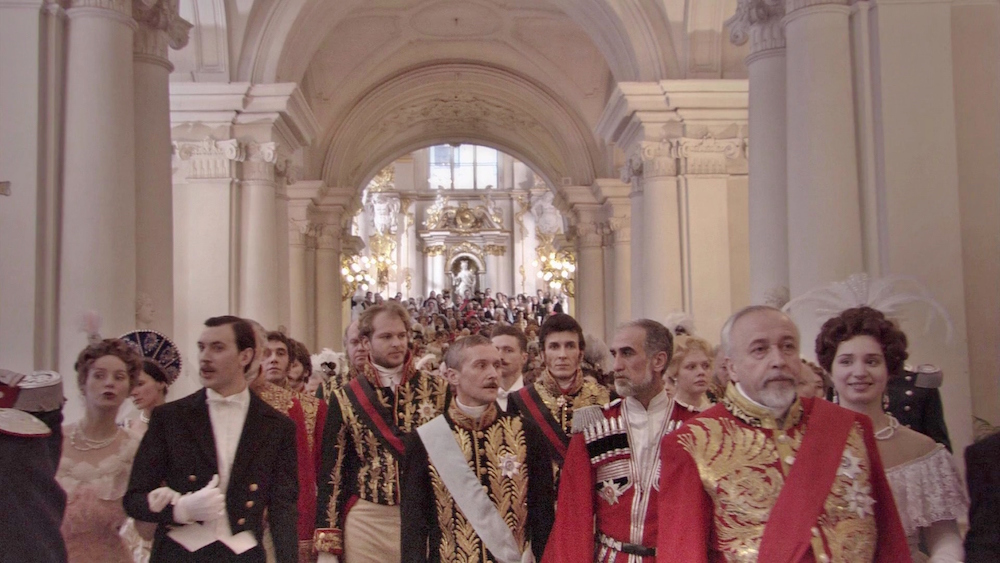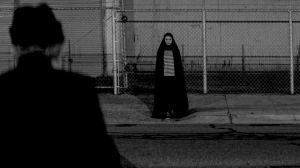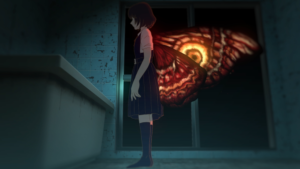
If there is any contemporary singular proof that the mainstream of film criticism is full of easily impressed, intellectually masturbatory pricks, it’s probably Russian Ark. One of the most lauded and legendary films of the new century, Russian Ark is shot in one take (lord, it won’t let you forget that) and shows us the perspective on a man who is unstuck in time in the Saint Petersburg Hermitage Museum, slipping freely between eras with the Marquis de Custine (a travel writer of the 1800s sort who is most famous for documenting the cultural and social state of Russia under Nicholas I), waxing philosophical about the beauty of aristocracy and refinement and a certain sense of “European-ness.” It is long (often excruciatingly drawn out even at 99 minutes), tedious, and poorly shot (difficultly shot, sure, but difficulty does not equal quality), and its central message is inherently reactionary, regressive, embarrassingly pro-Monarchy, and snivelingly sycophantic towards conservative ideology. It’s an ugly film that has no worthwhile sense of purpose, and its defenders either have to out themselves as cultural reactionaries themselves, or as people so self-satisfied at understanding references to art and history that the frankly grotesque wealth worship of the film can slide by them. Essentially, Russian Ark is Family Guy for people with art degrees.
Though the concept of the single take film is one that’s been toyed with often and somewhat regularly attempted, I’ve always questioned its use in more traditional filmmaking, not least because, well, when you shoot the entire film in a single take, a lot of those shots will be bad. Much has been made of Russian Ark‘s cinematography, but beyond one particular shot (the cruelty and meanness of will be discussed later) it fails on a moment by moment basis to rise beyond the abilities of a particularly smart film student, able to float the camera around without embarrassing himself but never rising to any higher occasion. The paintings that are our focus so often in the first half are shot in the kind of light that leaves noticeable, obscuring glare on said paintings, not purposefully obscuring them for thematic coherency but denying us the ability to even enjoy looking at gorgeous paintings up close, to see what the narrator is implied to see, to understand his viewpoint. The extended nature of the take is ungainly and strange, choosing shots that are the most economical for shooting’s sake and never those that are the most beautiful or the most appropriate. La Casa Muda, though by no means a classic, at least used editing trickery to break up its shooting gimmick, allowing better planning of framing, blocking, lighting, et al. If film is based in the moving image, and you have to sacrifice that image for your silly gimmick, then what is the point exactly?
But only if it stopped there. No, Russian Ark’s flaws extend far beyond bad frames and sloppy filmmaking. It is not content to be visually unspectacular, ugly, and, at best, plain–it must plumb the depths of cheap propaganda in what can only be described as a feature-length evocation of having a full blown fetish hard-on for the aristocracy. From frame one, the audience is expected to see the achievements of uber-wealthy Russians–especially the pre-Revolution monarchy and aristocracy–as being almost divine, as having a significance beyond the wealth that allowed their existence. It’s a film that asks us to find the Russian Revolution tragic, but then has no follow through on what made the Soviet Union its own sad tragedy. It assumes we agree (or beats us into submission until we agree) with its basic premises: Monarchy is good, the wealthy have a right to rule due to their advanced tastes in fine art, and anyone who would disagree otherwise is a big jerk dead-set on taking all of the joy out of Russian lives.
It is more than a bit shocking to see a Russian art film, a highly acclaimed one at that, argue for the preservation of opulence and ostentatious spending, to ignore completely the human cost of such opulence and spending; this is the land of Tarkovsky, Eisenstein, Klimov, Vertov, and Shepitko after all, none of who would be caught dead gushing over such grovelling greed-worship. If you’ve ever dreamed of a better explanation of commodity fetishism, Sokurov dutifully provides it with his bull-headed nonsense that high-mindedly offers exegesis on Fine Art yet never stoops its head to see where this Fine Art comes from and the people that must suffer so some dicks can wear ugly suit jackets. There are no relationships, only Beautiful Objects, divorced from history (how sick of a joke is that?) and divorced from all the human beings that had hands in its creation. It’s a dressier version of CEO doublespeak, of bootstraps-obsessed Republican hysteria. If anything, it might be worse–at least Republicans acknowledge that poor people exist before they murder them.
Russian Ark has one beautiful moment, and it’s the single moment most indicative of the film’s reprehensible, propagandist viewpoint. The camera follows Anastasia (yes, that one) and some other girls (none are explicitly named, but we can guess) as they run and twirl down an expansive, opulent hallway in gorgeous dresses, full of innocence and naivete and unhindered, simple beauty. Because of course they are. Because Sokurov is too much of a coward to present us with just aristocracy, he makes us implicit in the murder of children if we think that monarchy and tyranny are bad, if we have the gall to care about the proletariat. In this image, he says: anyone who thinks that ridiculous opulence and wealth are wrong, anyone who thinks the ruling class should share their riches, anyone who thinks that the absurd, positively garish nature of mega-wealth and the super-rich is not worth the death and exploitation of the working classes, well, they want these wonderful children dead. Anyone who would dare ask, “But who had to die to enable this ostentatious lifestyle?” is painted as not only an enemy, but a murderer of innocence. These kids are not developed, they are not considered, they are not cared for in any sense of artistic language, because Sokurov doesn’t care about them as people. They are brought out only to be exploited as bludgeoning tools to force one to fall in line with regressive conservatism or else. This is shameful. This is despicable.
But critics ate it up. They ate it up the way they eat up any smart person who flatters them, the way they put aside ideology and politics and philosophy to collectively suck off any hack director who tells them what they want to hear. How else to explain Russian Ark‘s reverence in “serious film” circles? So-called “liberal” Hollywood should’ve rejected its obvious and clear regressive viewpoint out of hand, but instead everyone seems to have fallen under the spell of being catered to. That’s the problem with smart people I guess–it feels so good having your ego stroked that morality ceases to motivate or guide you (such a strong pleasure response is it that even the venerable and respectable Mark Cousins includes it prominently in his Story of Film–perhaps the film’s single glaring err in judgement). Lots of films have shameful politics, but rarely are they so risible and, seemingly, so purposefully grotesque in their ends. Russian Ark is a despicable, cowardly film, and it has nothing interesting to say about the aesthetics or politics of contemporary cinema.
—
Directed by Alexander Sokurov; written by Boris Khaimsky, Anatoli Nikiforov, Svetlana Proskurina, and Alexander Sokurov; starring Sergey Dreyden and Mariya Kuznetsova; 99 minutes.



 Derek
Derek
 Isabelle
Isabelle